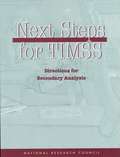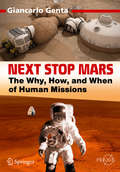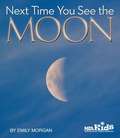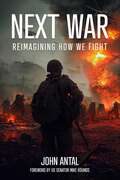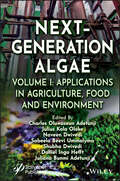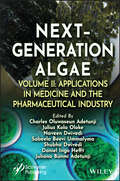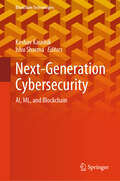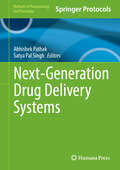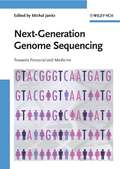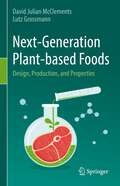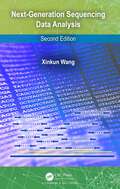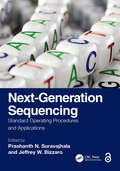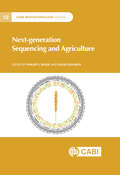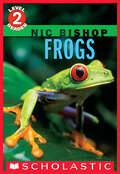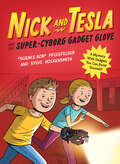- Table View
- List View
Next Steps for TIMSS: Directions for Secondary Analysis
by Board on International Comparative Studies in EducationA report on Directions for Secondary Analysis
Next Stop Mars
by Giancarlo GentaThis book covers the possible manned mission to Mars first discussed in the 1950s and still a topic of much debate, addressing historic and future plans to visit the Red Planet. Considering the environmental dangers and the engineering and design needed for a successful trip, it covers every aspect of a possible mission and outpost. The chapters explain the motivations behind the plan to go to Mars, as well as the physical factors that astronauts on manned missions will face on Mars and in transit. The author provides a comprehensive exposure to the infrastructure needs on Mars itself, covering an array of facilities including power sources, as well as addressing earth-based communication networks that will be necessary. Mechanisms for return to Earth are also addressed. As the reality of a manned Mars voyage becomes more concrete, the details are still largely up in the air. This book presents an overview of proposed approaches past, present, and future, both from NASA and, increasingly, from other space agencies and private companies. It clearly displays the challenges and the ingenious solutions involved in reaching Mars with human explorers.
Next Time You See the Moon
by Emily MorganThis book inspires children to observe the Moon. Readers will learn how the Moon's changing shape is caused by its orbit around the Earth.
Next War: Reimagining How We Fight
by John F. Antal"...a useful addition to the literature of the changing character of war. Its scoping and focus, and its application of the identified disruptors to current challenges offer immediate insights for today’s commanders and defence policymakers." — The Wavell Room The nature of war is constant change. We live in an era of exponential technological acceleration which is transforming how wars are waged. Today, the battlespace is transparent; multi-domain sensors can see anything, and long-range precision fire can target everything that is observed. Autonomous weapons can be unleashed into the battlespace and attack any target from above, hitting the weakest point of tanks and armored vehicles. The velocity of war is hyper-fast. Battle shock is the operational, informational, and organizational paralysis induced by the rapid convergence of key disrupters in the battlespace. It occurs when the tempo of operations is so fast, and the means so overwhelming, that the enemy cannot think, decide, or act in time. Hit with too many attacks in multiple domains, all occurring simultaneously, the enemy is paralyzed. In short, the keys to decisive victory in war is to generate battle shock. Imagine a peer fight against Communist China, a new war in Europe against a resurgent Russia, or a conflict against Iran in the Middle East. How can our forces survive an enemy-first strike in these circumstances? Can we adapt to the ever-accelerating tempo of war? Will our forces be able to mask from enemy sensors? How will leaders execute command and control in a degraded communications environment? Will our command posts survive? Will our commanders see and understand what is happening in order to plan, decide, and act in real time? This book addresses these tough questions and more.
Next-Generation Algae, Volume 1: Applications in Agriculture, Food and Environment
by Charles Oluwaseun Adetunji Juliana Bunmi Adetunji Naveen Dwivedi Shubha Dwivedi Julius Kola Oloke Sabeela Beevi Ummalyma Daniel Ingo HefftNEXT-GENERATION ALGAE This book brings together experts in relevant fields to describe the successful application of algae and their derivatives in agriculture, improving agricultural sustainability, harvesting and processing, food security, fishery, aquafarming, agriculture pollution, and state-of-the-art developments of algae in commercial and agriculture utilization. This book provides up-to-date and cutting-edge information on the application of algae in producing sustainable solutions to various challenges that arise from an increase in agricultural production, as well as its utilization in the bioremediation of industrial wastewater. Moreover, the book provides detailed information about the recent advancements in smart microalgae wastewater treatment using Internet of Things (IoT) and edge computing applications. Other topics covered include the use of microalgae in various applications; the use of algae to remove arsenic; algae’s role in plastic biodegradation, heavy metal bioremediation, and toxicity removal from industrial wastewater; the application of DNA transfer techniques in algae; the use of algae as food and in the production of food, ascorbic acid, health food, supplements, and food surrogates; relevant biostimulants and biofertilizers that could be derived from cyanobacterials and their role in sustainable agriculture; and algae’s application in the effective production of biofuels and bioenergy. Audience This book is aimed at a diverse audience including professionals, scientists, environmentalists, industrialists, researchers, innovators, and policymakers who have an interest in bioremediation technologies for extremely polluted environments, especially in water, air, and soil.
Next-Generation Algae, Volume 2: Applications in Medicine and the Pharmaceutical Industry
by Charles Oluwaseun Adetunji Juliana Bunmi Adetunji Naveen Dwivedi Shubha Dwivedi Julius Kola Oloke Sabeela Beevi Ummalyma Daniel Ingo HefftNEXT-GENERATION ALGAE The book comprehensively details the novel and biologically active compounds derived from algae for sustainable healthcare delivery that could be used for the treatment of an ever-increasing population, prevention of high rate of morbidity rates, as well as in the treatment of numerous diseases, and serve as an alternative drug for the prevention of high level of resistance to synthetic drugs. This second volume places a special emphasis on the discovery of novel and biologically active compounds from algae. It covers a wide range of applications, including the use of astaxanthin and carotenoids derived from algae for the production of nutraceuticals, pharmaceuticals, additives, food supplements, and feed. The book also discusses the production of polyunsaturated fatty acids (PUFAs) and their biomedical applications, recent advancements in the research of sulfated polysaccharides from algal origin, and their antiulcer bioactivities. Other topics include the application of algae in wound healing, the use of nanotechnology for the bioengineering of useful metabolites derived from algae and their multifaceted applications, and the production of single-cell proteins and pigments with high relevance in the industry. Audience Researchers in industry and academia as well as clinicians in the fields of microbiology, biotechnology, and food science will find this book very pertinent.
Next-Generation Cybersecurity: AI, ML, and Blockchain (Blockchain Technologies)
by Keshav Kaushik Ishu SharmaThis book highlights a comprehensive overview of the recent advancements and challenges in the field of cybersecurity with a focus on the integration of artificial intelligence (AI), machine learning (ML), and blockchain technologies. The book targets both researchers and practitioners working in the field of cybersecurity and aims to fill the gap in the current literature by providing a comprehensive and up-to-date examination of the integration of AI, ML, and blockchain in cybersecurity systems. The book has a technical focus and provides an in-depthexamination of the latest developments in the field. It covers a range of topics including the basics of AI, ML, and blockchain, the application of AI and ML in cybersecurity, the use of blockchain in cybersecurity, and the integrationof AI, ML, and blockchain in cybersecurity systems. Each chapter is written by leading experts in the field and provides a thorough and technical overview of the topic, including case studies, examples, and practical applications.
Next-Generation Drug Delivery Systems (Methods in Pharmacology and Toxicology)
by Abhishek Pathak Satya Pal SinghThis book provides a detailed yet accessible guide to emerging trends in drug delivery systems. Topics encompass a wide range of delivery mechanisms, including nanotechnology-based carriers, controlled-release formulations, targeted delivery systems, and biologics, with a focus on their role in improving therapeutic outcomes. Emphasis has also been placed on regulatory challenges, translational research, and the integration of artificial intelligence in designing advanced drug delivery systems. Written for the Methods in Pharmacology and Toxicology series, chapters include the kind of specificity and expert implementation advice to ensure success in the lab. Comprehensive and practical, Next-Generation Drug Delivery Systems serves as an ideal guide to how innovative drug delivery approaches can address critical challenges, such as enhancing bioavailability, reducing side effects, and achieving precise drug targeting.
Next-Generation Electrochromic Devices: From Multifunctional Materials to Smart Glasses
by Pierluigi CossariComprehensive reference focusing on features of promising new materials and devices for electrochromic and integrated multifunctional systems Next-Generation Electrochromic Devices: From Multifunctional Materials to Smart Glasses covers the basic concepts and the potential use of electrolytes, conducting polymers and multifunctional materials for the development of electrochromic (EC) and integrated systems, focusing on the influence of solid-state electrolytes and interface features on the design of new device structures and simplified manufacturing. The book is divided into three parts. Part I explores the chemistry of the main components of devices with a special focus on the main critical material issues, covering mixed-ion and electron conductors, electrodes, and more. Part II describes EC and multifunctional devices, such as photoelectrochromic smart windows and see-through ECOLED displays, and the main characterization techniques for the study of material properties, interfaces and device performance. Part III comprehends device manufacturing, scale-up procedures, and discusses the main benefits of smart windows in terms of energy savings, visual comfort, and environmental impact, proposing contextually a multitude of pioneering ideas and concepts with a specific insight into emerging devices in the era of Artificial Intelligence (AI), immersive reality and invisible technologies. Next-Generation Electrochromic Devices includes information on: Inorganic and organic electrochromic materials, including graphene, 3D transitional metal oxides, Prussian blue, viologens, conducting polymers, organic mixed ionic and electronic materials, and highly transparent electrodes Electrolytes including inorganic, liquid, gel, and solid-state polymers, their ionic conductivity and transport properties Thin film deposition methods: chemical deposition through solution processing techniques, sol-gel, Langmuir-Blodgett, electrochemical and physical deposition by means thermal and electron-beam evaporation, sputtering, pulsed laser, and molecular beam epitaxy deposition Electrochemical analysis of materials, interface, and device durability Organic mixed ionic and electronic conductor materials for innovative and multifunctional optoelectronic systems Optical, structural, chemical, and physical methods for the study of electrochromism and material properties including NMR, X-Ray diffraction analysis, XPS, UV-Vis, FTIR, and Raman spectroscopy Energy efficiency of EC glazings and their impact on thermal and visual comfort Emerging materials for chromogenic systems, smart windows, and new energy devices Fully integrated ECOLED see-through displays and multifunctional smart devices for immersive reality and invisible technologies Impact of AI and next-generation technologies on social, human, and environmental changes Next-Generation Electrochromic Devices is an essential reference on the subject for materials scientists, chemists, physicists, as well as architects, electrical and civil engineers. It can be also a source of inspiration for artists, graphic designers, and art workers.
Next-Generation Genome Sequencing: Towards Personalized Medicine
by Michal JanitzWritten by leading experts from industry and academia, this first single comprehensive resource addresses recent developments in next generation DNA sequencing technology and their impact on genome research, drug discovery and health care. As such, it presents a detailed comparative analysis of commercially available platforms as well as insights into alternative, emerging sequencing techniques. In addition, the book not only covers the principles of DNA sequencing techniques but also social, ethical and commercial aspects, the concept of personalized medicine and a five-year perspective of DNA sequencing.
Next-Generation Nanobiosensor Devices for Point-Of-Care Diagnostics
by Gorachand DuttaThis book reviews the potential of next-generation point-of-care diagnosis in healthcare. It also discusses the printed chip-based assay (Lab-on-a-Chip, Lab-on-a-PCB) for rapid, inexpensive biomarkers detection. The book presents the development of sensory systems based on the use of nanomaterials. It examines different biosensors for medical diagnosis using surface modification strategies of transducers. It presents electrochemical concepts based on different nanobiomaterials and nanocomposites for cancer theranostics. Notably, the book examines the recent advances in wearable, cost-effective hemodynamic sensors to detect diseases at an early stage. It further explores the combination of redox cycling and electrochemical detection to develop ultrasensitive and reproducible biosensors for point-of-care testing. Finally, the book summarizes the significant challenges in the point of care diagnostics and its future opportunities in healthcare.
Next-Generation Plant Breeding Approaches for Stress Resilience in Cereal Crops
by S. Chandra Nayaka Mallana Gowdra Mallikarjuna Tanushri KaulThis edited book highlights the gravity and efficacy of next-generation breeding tools for the enhancement of stress-resilience in cereals, especially in the context of climate change, pests, diseases, and abiotic stresses. The content of the book helps in understanding the application of emerging genetic concepts and neoteric genomic approaches in cereal breeding. It collates all the latest information about enhancing the stress resilience in cereal crops for overcoming food security issues. Cereals have predominantly been used as a staple food since time immemorial and contribute more than 50% of the caloric requirement of the global population. However, in cereals, the yield losses due to various stresses are very high, considering the crop growth stage and stress sensitivity. Therefore, to feed and nourish the generations in the era of climate change, it is imperative to develop stress-resilient cereal cultivars. This book explores newly developed next-generation breeding tools, viz., genome-wide association studies, genomic prediction, genome editing, and accelerated generation advancement methodologies, which revealed promising outcomes by enhancing the stress resilience in cereals with yield potential. This book is useful for postgraduate students specializing in plant breeding, plant stress physiology, plant genomics, agriculture, and agronomy. It is of immense value to scientific community involved in teaching, research, and extension activities related to cereal cultivation.
Next-Generation Plant-based Foods: Design, Production, and Properties
by David Julian McClements Lutz GrossmannThe creation of plant-based foods is one of the most rapidly advancing areas in the modern food industry. Many consumers are adopting more plant-based foods in their diets because of concerns about global warming and its devastating impacts on the environment and biodiversity. In addition, consumers are adopting plant-based diets for ethical and health reasons. As a result, many food companies are developing plant-based analogs of animal-based foods like dairy, egg, meat, and seafood products. This is extremely challenging because of the complex structure and composition of these animal-based foods.Next-Generation Plant-based Foods: Design, Production and Properties presents the science and technology behind the design, production, and utilization of plant-based foods. Readers will find a review of ingredients, processing operations, nutrition, quality attributes, and specific plant-based food categories such as milk and dairy products, egg and egg products, meat and seafood products, providing the fundamental knowledge required to create the next generation of healthier and more sustainable plant-based food alternatives.
Next-Generation Sequencing Data Analysis
by Xinkun WangRNA-seq: both bulk and single-cell (separate chapters) Genotyping and variant discovery through whole genome/exome sequencing Clinical sequencing and detection of actionable variants De novo genome assembly ChIP-seq to map protein-DNA interactions Epigenomics through DNA methylation sequencing Metagenome sequencing for microbiome analysis
Next-Generation Sequencing: Standard Operating Procedures and Applications
by Prashanth N. Suravajhala Jeffrey W. BizzaroThis cutting-edge reference book compiles standard operating procedures, protocols, and applications of next-generation sequencing (NGS). It discusses genomic testing applications through NGS. It pays special focus on the protocols for cataloguing variants of uncertain significance. Over the years, NGS and advanced bioinformatics approaches have allowed the transition of genomic assays into translational practices. The book covers visualisation of NGS datasets, investigation of early development impairment, and metagenome protocols. It also discusses the challenges in NGS methods.Key Points: Includes case studies of application of NGS in different taxa like humans, rodents, plants, and bacteria Compiles protocols from various reputed companies like Illumina, PacBio, and ThermoFisher Discusses the translational applications of NGS methods Reviews machine learning heuristics for NGS data interpretation Discusses emerging genomic assay technologies and characterising mechanisms of disease prevalence The book is meant for researchers and industry experts in genomics, computational biology, and bioinformatics.Chapter 7 and 9 of this book is freely available as a downloadable Open Access PDF at http://www.taylorfrancis.com under a Creative Commons [Attribution-Non Commercial-No Derivatives (CC BY-NC-ND)] 4.0 license.
Next-generation Sequencing and Agriculture (CABI Biotechnology Series)
by Edited by Philipp E. Bayer, David EdwardsGenome sequencing has become a basic tool of plant and animal breeding. Reduced costs have allowed the sequencing of thousands of plant lines or cultivars, leading to previously unobtainable insights into genetic impacts during breeding and generating large numbers of novel candidate breeding genes. This book summarizes the impacts that the genome sequencing revolution has had on agriculture with reference to applications across species and locations. It explains new techniques and their use in understanding epigenetics, breeding and conservation. It is a useful resource for scientists wanting to learn how different fields of agriculture have adapted novel genome sequencing technologies to their requirements, and for those wanting to transfer technologies and lessons learned from one field of agriculture to another. This book is a useful resource for students and researchers in biotechnology, genetics, genomics and breeding.
Nexus of Sustainability: Understanding of FEWSE Systems І (Studies in Systems, Decision and Control #559)
by Artur Zaporozhets Viacheslav Bogdanov Anatoly ZagorodnyThe intricate interplay between food, energy, water, societal dynamics, and the environment constitutes the bedrock of contemporary global challenges. In recent decades, this convergence has emerged as a focal point for scientific inquiry, policy formulation, and societal discourse. This book seeks to meticulously unravel the complexities inherent in this nexus, shedding profound light on the interconnected risks, vulnerabilities, and transformative opportunities that define our quest for sustainability in the twenty-first century. The materials of this book were prepared mainly by authors working on the joint project between the International Institute for Applied Systems Analysis (IIASA) and the National Academy of Sciences (NAS) of Ukraine “Integrated robust modeling and management of food-energy-water-land use nexus for sustainable development”, and on the project “Comprehensive analysis of robust preventive and adaptive measures of food, energy, water, and social management in the context of systemic risks and consequences of COVID-19” (0122U000552) of the NAS of Ukraine. Members of the System Analysis Committee of the NAS of Ukraine were also involved in the preparation of book chapters. The authors dedicate this book to the memory of the Academician of NAS of Ukraine, Professor Yuri Ermoliev, who died in October 2022 and made a fundamental contribution to stochastic optimization as a basic tool for quantitative risk management. This book largely follows his ideas about risk management and its applications.
Nexus: Small Worlds and the Groundbreaking Theory of Networks
by Mark BuchananAs Chaos explained the science of disorder, Nexus reveals the new science of connection and the odd logic of six degrees of separation. "If you ever wanted to know how many links connect you and the Pope, or why when the U.S. Federal Reserve Bank sneezes the global economy catches cold, read this book," writes John L. Casti (Santa Fe Institute). This "cogent and engaging" (Nature) work presents the fundamental principles of the emerging field of "small-worlds" theory--the idea that a hidden pattern is the key to how networks interact and exchange information, whether that network is the information highway or the firing of neurons in the brain. Mathematicians, physicists, computer scientists, and social scientists are working to decipher this complex organizational system, for it may yield a blueprint of dynamic interactions within our physical as well as social worlds. Highlighting groundbreaking research behind network theory, "Mark Buchanan's graceful, lucid, nontechnical and entertaining prose" (Mark Granovetter) documents the mounting support among various disciplines for the small-worlds idea and demonstrates its practical applications to diverse problems--from the volatile global economy or the Human Genome Project to the spread of infectious disease or ecological damage. Nexus is an exciting introduction to the hidden geometry that weaves our lives so inextricably together.
Nezhat's Operative Gynecologic Laparoscopy and Hysteroscopy
by Camran Nezhat Farr Nezhat Ceana NezhatThis book catalogs the full spectrum of minimally invasive procedures in gynecology, oncology, and infertility treatment. High-quality color pictures supplement many of the presentations. The book covers subjects as varied as endometriosis, urinary incontinence, infertility, ovarian cancer, and appendiceal disease. It also discusses general surgical laparoscopic issues and the management of complications during laparoscopy. The three editors have pioneered some of the most important laparoscopic procedures used today, and their work has opened up the video laparoscopy field for surgeons worldwide. The contributors have extensive experience in laparoscopy and hysteroscopy. Many of them have established some of the surgical techniques discussed.
Nic Bishop: Frogs (Scholastic Reader, Level 2)
by Nic BishopJoin photographer and biologist Nic Bishop as he takes a closer look at frogs.Now even the youngest readers can join Sibert Medal-winning photographer and biologist Nic Bishop as he takes a closer look at the world's most amazing animals. In this book, adapted from his award-winning hardcover, Nic introduces fun facts about frogs and their bodies, habits, and life cycle. The simple, easy-to-read Level 2 text is perfect for beginners, and the eye-catching photographs will delight naturalists of all ages. This reader includes a brief author's note, glossary, and accessible visual index.
Niche Construction: How Life Contributes to Its Own Evolution (Monographs In Population Biology Ser. #37)
by John Odling-SmeeHow niche construction theory extends evolutionary theory beyond natural selection to a more general theory about the coevolution of organisms with their environments.In Niche Construction, John Odling-Smee, the leading authority on niche construction theory, extends evolutionary theory from an explanation of how populations of organisms respond to natural selection pressures in their environments to a more general theory about the coevolution of organisms with their environments. Organisms, he shows, cause changes in their local external environments by interacting with them, thereby contributing in fundamental ways to their own and one another&’s evolution. This book applies niche construction theory to current problems such as human-induced global warming and suggests how humans might contribute positively to the future evolution of life on Earth.Odling-Smee explains how orthodox evolutionary theory falls short in two ways. First, it does not describe how organisms contribute to their own and one another&’s evolution through their environment-changing niche constructing activities. Second, it fails to explain how genetic evolution can give rise to supplementary knowledge-gaining processes in many species. These include certain developmental processes in individual organisms and socio-cultural processes in animals, including humans. Neo-Darwinism, the author writes, assesses the fitness of individual organisms in populations in terms of their capacity to survive and reproduce, but without attributing these capacities to the active, purposeful agency of organisms. He argues that the purposeful agency of individual organisms plays a central role in evolution. He also discusses the relationship of an organism&’s energy-consuming activities and the second law of thermodynamics.
Nick and Tesla and the High-Voltage Danger Lab: A Mystery with Gadgets You Can Build Yourself (Nick and Tesla #1)
by Steve Hockensmith Bob PflugfelderSolve mysteries using DIY science projects with twin sleuths Nick and Tesla in this zany, action-packed middle grade adventure by "Science Bob" Pflugfelder!Summer break is about to get weird. After their parents disappear, twins Nick and Tesla are sent to live with their Uncle Newt, an eccentric inventor with his very own science lab. Soon, the young sleuths find themselves investigating a mysterious family right in their own neighborhood. As they race to uncover the truth, Nick and Tesla must build a bottle rocket launcher, a 9-volt battery burglar alarm, and an electromagnet picker-upper to save the day.Now in paperback, the first book in the popular Nick and Tesla series features laugh-out-loud jokes, fun illustrations, and five DIY science projects with step-by-step instructions for readers to try at home.
Nick and Tesla and the Robot Army Rampage: A Mystery with Gadgets You Can Build Yourself (Nick and Tesla #2)
by Steve Hockensmith Bob PflugfelderJoin twins Nick and Tesla as they build homemade robots and race to solve a mystery in this zany, action-packed middle grade adventure sequel by &“Science Bob&” Pflugfelder.It&’s up to Nick and Tesla to save the day–again! When a rash of robberies hits the town of Half Moon Bay, the two young sleuths head straight to their Uncle Newt&’s science lab. They&’ll have to build their very own battlebots, robo-bugs, and hoverbots to outsmart a criminal mastermind. Can Nick and Tesla crack the case before it's too late? Now in paperback, this second book in the popular Nick and Tesla series features laugh-out-loud jokes, fun illustrations, and five DIY science projects with step-by-step instructions for readers to try at home.
Nick and Tesla and the Secret Agent Gadget Battle: A Mystery with Gadgets You Can Build Yourself (Nick and Tesla #3)
by Steve Hockensmith Bob PflugfelderUncover a secret agent and build spy gadgets with twin sleuths Nick and Tesla in this zany, action-packed middle grade adventure by &“Science Bob&” Pflugfelder!After rescuing a kidnapped heiress and taking down a robot army, 11-year-old twins Nick and Tesla could really use a break. But before they can kick back and relax, the young sleuths discover there's a spy in their midst! Someone in the town of Half Moon Bay is spying on their Uncle Newt, an eccentric inventor. To uncover the true identity of this secret agent, Nick and Tesla must build their own spy gadgets, from burglar alarms and code wheels to a water balloon trap and more. Now in paperback, this third book in the popular Nick and Tesla series features laugh-out-loud jokes, fun illustrations, and five DIY science projects with step-by-step instructions for readers to try at home.
Nick and Tesla and the Super-Cyborg Gadget Glove: A Mystery with Gadgets You Can Build Yourself (Nick and Tesla #4)
by Steve Hockensmith Bob PflugfelderBuild a super-cyborg gadget glove and save the science museum with twin sleuths Nick and Tesla in this zany, action-packed middle grade adventure by &“Science Bob&” Pflugfelder!Just like their eccentric genius Uncle Newt, 11-year-old twins Nick and Tesla love science—and they can't wait for the grand reopening of the science museum in Half Moon Bay. But when someone sabotages the new Hall of Genius exhibit, the animatronic replicas of history's greatest scientists go haywire. The two young sleuths must engineer their very own DIY super-cyborg gadget glove—complete with a false-alarm alarm, a UV-light secret message reader, and more—to catch the culprit and save the museum. Now in paperback, this fourth book in the popular Nick and Tesla series features laugh-out-loud jokes, fun illustrations, and four DIY science projects with step-by-step instructions for readers to try at home.
